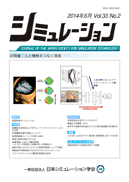巻号一覧

6 巻 (2014)
- 4 号 p. 43-
- 3 号 p. 37-
- 2 号 p. 15-
- 1 号 p. 1-
6 巻, 2 号
選択された号の論文の2件中1~2を表示しています
- |<
- <
- 1
- >
- >|
論文
-
河村 拓馬, 井戸村 泰宏, 宮村(中村) 浩子, 武宮 博2014 年6 巻2 号 p. 15-26
発行日: 2014年
公開日: 2014/09/05
ジャーナル フリーIn this paper, we propose a novel remote visualization system based on particle-based volume rendering (PBVR)1), which enables interactive analyses of extreme scale volume data located on remote computing systems. The system consists of a Server, which generates particles (rendering primitives), and a Client, which process volume rendering, and particles are transferred from Server to Client. The size of particle data is determined by the resolution of rendering images, and is significantly smaller than the original volume data. Therefore, the system enables an interactive visualization without transferring huge volume data. The smallness of the particle data is useful also for achieving a high frame rate. In the system, Server is highly parallelized on multiple General Purpose Graphic Processing Units (GPGPUs) using a hybrid MPI-CUDA programing model. The particle generation is accelerated by two orders of magnitudes compared with CPU, and structured and unstructured volume data with ~108 cells are processed within a second. The total performance of remote visualization is compared against a commodity visualization tool, and from 7x to 48x faster processing speed is achieved.
抄録全体を表示PDF形式でダウンロード (1418K) -
吉田 好邦, 北里 雅史, 石谷 久2014 年6 巻2 号 p. 27-36
発行日: 2014年
公開日: 2014/09/05
ジャーナル フリーBased on the questionnaire survey on new generation vehicles, we analyze consumers preference for an owned car and a candidate car at the point of purchase. Using AHP (Analytic Hierarchy Process), we simulate the change of preference in the case that fuel-efficiency of the candidate car is assumed to improve. In the result, we lead the individual attributes of potential users of new generation vehicles.
Potential users lay weight on fuel-efficiency and are economically rational. This is supported by the statistically significant correlation between potential user ratio and individual attribute such as annual income, the price of an owned car. Then, we classify respondents into two groups, consumers who consider total costs from the vehicle price and the fuel-efficiency, and consumers who consider them separately. While the former group has higher potential user ratio, the latter group has potential users who lay weight on fuel-efficiency except from economic performance. We also analyze the factor of changed preference by multiple regressions. As the factors of preference for high fuel efficiency, age and sex of the respondents as well as fuel efficiency and producer dummy of their owned car were chosen.
抄録全体を表示PDF形式でダウンロード (1344K)
- |<
- <
- 1
- >
- >|